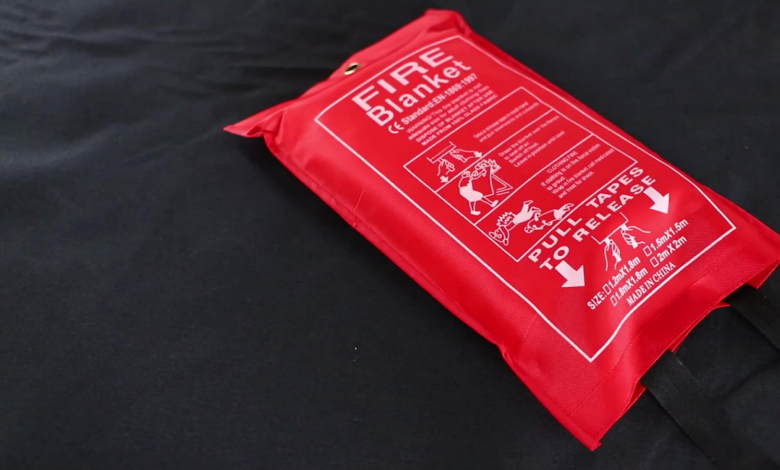The Role of Fire Blankets in Home Safety

When we think about fire safety in our homes, our minds often gravitate towards smoke detectors, fire extinguishers, and escape plans. However, there is another crucial, yet often overlooked, tool in our fire safety arsenal: the fire blanket. Fire blankets can be a vital first line of defense against small fires, offering a quick and effective means to control and extinguish flames. Alongside these safety tools, it’s important to have a Fire Safety Certificate London to ensure your fire systems are safe. This blog explores the role of fire blankets in home safety, their benefits, proper usage, and maintenance.
What is a Fire Blanket?
A fire blanket is a safety device designed to extinguish small fires. It is made from fire-resistant materials such as fiberglass or woven Kevlar, which can withstand high temperatures. Fire blankets are typically stored in a quick-release container and can be deployed swiftly in an emergency. They work by smothering the fire, cutting off the oxygen supply, and thereby stopping the flames.
Benefits of Fire Blankets
- Ease of Use: Fire blankets are incredibly user-friendly. Unlike fire extinguishers, which require a certain degree of know-how and practice to operate effectively, fire blankets can be used by anyone, including children and elderly individuals. Simply pull the blanket from its container, unfold it, and place it over the flames.
- Immediate Response: In the crucial moments when a fire starts, immediate action is essential. Fire blankets provide an immediate response to small fires, often before they have a chance to spread. This can be especially important in kitchens, where most home fires begin.
- Versatility: Fire blankets can be used on various types of fires, including grease fires, which are common in kitchens and cannot be extinguished with water. They can also be used to wrap around a person whose clothing has caught fire, helping to extinguish the flames and prevent further injury.
- Minimal Cleanup: Unlike fire extinguishers, which can leave a considerable mess of chemical residue, fire blankets cause minimal disruption. This makes them particularly useful in settings where cleanliness is a priority, such as in kitchens or around sensitive electronics.
Proper Usage of Fire Blankets
To maximize the effectiveness of a fire blanket, it’s crucial to understand how and when to use it properly.
- Assess the Fire: Fire blankets are designed for small, contained fires. If the fire is larger than a wastepaper basket or spreading rapidly, evacuate the area immediately and call emergency services. Do not attempt to tackle large fires with a fire blanket.
- Deployment: When deploying the fire blanket, protect your hands by holding the corners of the blanket over your hands. This will prevent burns and allow you to place the blanket over the fire safely.
- Cover the Flames: Carefully place the blanket over the fire, ensuring that it completely covers the flames and the base of the fire. Do not throw the blanket, as this can cause the flames to spread.
- Leave the Blanket in Place: Once the fire is covered, leave the blanket in place until it has cooled completely. Removing it too soon can allow the fire to reignite.
- Evacuate if Necessary: If the fire cannot be controlled with the fire blanket, evacuate the premises and call the fire department. Do not risk personal safety by staying in a dangerous situation.
Maintenance and Placement
To ensure that a fire blanket is effective in an emergency, proper maintenance and strategic placement are essential.
- Regular Inspections: Check your fire blanket regularly for signs of wear or damage. Replace it if the material appears compromised in any way. Many manufacturers recommend replacing fire blankets every five to seven years, regardless of use.
- Accessible Location: Place fire blankets in locations where fires are most likely to occur, such as kitchens, garages, and near fireplaces. Ensure that they are easily accessible and not obstructed by other items.
- Training and Awareness: Educate all members of the household on the location and proper use of fire blankets. Regularly review fire safety procedures to ensure everyone is prepared in case of an emergency.
The Importance of a Comprehensive Fire Safety Plan
While fire blankets are an essential tool in home fire safety, they should not be the sole component of your fire safety plan. A comprehensive approach includes multiple layers of protection and preparedness:
- Smoke Detectors: Install smoke detectors on every level of your home, inside bedrooms, and outside sleeping areas. Test them monthly and replace the batteries at least once a year.
- Fire Extinguishers: Have fire extinguishers readily available in key areas such as the kitchen, garage, and near exits. Ensure that everyone in the household knows how to use them.
- Escape Plan: Develop and practice a fire escape plan with all household members. Identify multiple exits from each room and establish a meeting place outside the home.
- Fire-Resistant Materials: Consider using fire-resistant building materials and furnishings in your home to reduce the risk of fire spread.
Conclusion
Fire blankets are a valuable, yet often underutilized, tool in home fire safety. Their simplicity, effectiveness, and versatility make them an excellent addition to any fire safety plan. By understanding their benefits, proper usage, and maintenance, you can enhance your home’s safety and be better prepared to handle small fires quickly and effectively. However, remember that fire blankets are just one part of a comprehensive fire safety strategy, which should also include smoke detectors, fire extinguishers, and a well-practiced escape plan. Additionally, it’s important to consider services like Landlord Certification for comprehensive landlord safety certificates, ensuring all aspects of your home’s safety are covered. Together, these measures can provide a robust defense against the threat of fire, helping to protect your home and loved ones. If you want to stay updated with posts like this, please follow us on TechyDaily.



